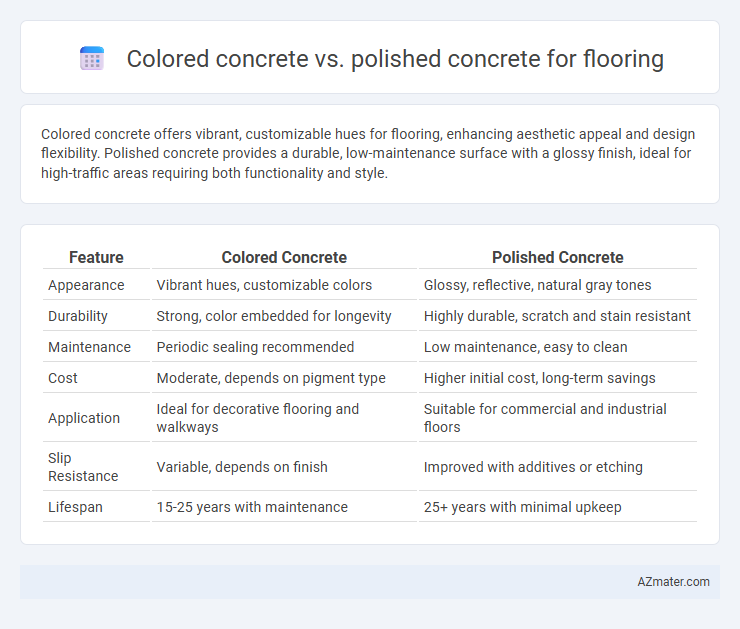Colored concrete offers vibrant, customizable hues for flooring, enhancing aesthetic appeal and design flexibility. Polished concrete provides a durable, low-maintenance surface with a glossy finish, ideal for high-traffic areas requiring both functionality and style.
Table of Comparison
| Feature | Colored Concrete | Polished Concrete |
|---|---|---|
| Appearance | Vibrant hues, customizable colors | Glossy, reflective, natural gray tones |
| Durability | Strong, color embedded for longevity | Highly durable, scratch and stain resistant |
| Maintenance | Periodic sealing recommended | Low maintenance, easy to clean |
| Cost | Moderate, depends on pigment type | Higher initial cost, long-term savings |
| Application | Ideal for decorative flooring and walkways | Suitable for commercial and industrial floors |
| Slip Resistance | Variable, depends on finish | Improved with additives or etching |
| Lifespan | 15-25 years with maintenance | 25+ years with minimal upkeep |
Introduction to Colored and Polished Concrete Flooring
Colored concrete flooring offers vibrant, customizable hues through integral pigments or surface staining, enhancing aesthetic appeal in residential and commercial spaces. Polished concrete flooring achieves a high-gloss finish by grinding and sealing the surface, improving durability and reducing maintenance requirements. Both methods provide durable, cost-effective flooring solutions with unique visual and functional benefits tailored to various design needs.
Aesthetic Differences: Color Options vs. High-Gloss Finish
Colored concrete offers a wide range of vibrant hues, allowing customization with pigments, stains, or dyes to create unique, visually appealing floors. Polished concrete emphasizes a high-gloss finish achieved through mechanical grinding and polishing, enhancing the floor's natural aggregate and providing a sleek, reflective surface. While colored concrete focuses on diverse color palettes, polished concrete highlights surface texture and shine for a modern, sophisticated look.
Durability and Longevity Comparison
Colored concrete offers excellent durability with its pigmented mix resisting fading and surface wear, making it ideal for high-traffic areas. Polished concrete features a hardened surface layer enhanced by densifiers and sealers, providing superior scratch resistance and longevity that can exceed 20 years with minimal maintenance. Both flooring options deliver robust performance, but polished concrete generally exhibits greater lifespan and wear resistance in industrial and commercial settings.
Installation Process: Timelines and Techniques
Colored concrete flooring involves the integration of pigments during the mixing or overlay application stage, with installation typically taking 2-4 days depending on area size and drying conditions. Polished concrete requires a multi-step grinding process using progressively finer diamond abrasives, followed by densification and polishing, which can extend the timeline to 4-7 days based on surface condition and desired sheen. Both methods demand precise surface preparation but colored concrete often allows faster setup, whereas polished concrete's technique-intensive process provides a durable, low-maintenance finish.
Maintenance Requirements and Ease of Cleaning
Colored concrete requires regular sealing to maintain its vibrant hues and prevent staining, with routine sweeping and occasional mopping sufficient for everyday cleaning. Polished concrete demands less frequent sealing but benefits from periodic re-polishing to preserve its smooth, reflective surface, while its dense finish resists dirt and makes cleaning simple with just dry dust mopping or wet cleaning. Both options offer durable surfaces, but polished concrete generally offers easier maintenance and superior stain resistance compared to colored concrete.
Cost Analysis: Initial Investment and Long-Term Savings
Colored concrete flooring generally requires a lower initial investment compared to polished concrete due to simpler installation and fewer processing steps. Polished concrete, while costlier upfront because of grinding, honing, and sealing processes, offers long-term savings through enhanced durability, reduced maintenance, and higher resistance to wear and stains. Over time, polished concrete's extended lifespan and minimal upkeep expenses often result in a more cost-effective flooring solution despite its higher initial cost.
Slip Resistance and Safety Considerations
Colored concrete offers enhanced slip resistance due to textured finishes and embedded aggregates that increase traction, making it a safer option for high-traffic or wet areas. Polished concrete, while aesthetically appealing with its smooth and reflective surface, can be more slippery when wet unless treated with anti-slip coatings or additives. Safety considerations must prioritize the specific environment and foot traffic, balancing the visual appeal of polished concrete with the functional slip resistance provided by colored concrete finishes.
Environmental Impact: Sustainability Factors
Colored concrete flooring often incorporates pigments without altering the base material's composition, maintaining its inherent durability and minimizing environmental disruption, while polished concrete flooring enhances existing concrete surfaces by grinding and sealing, reducing the need for additional materials and waste. The sustainability of polished concrete is notable due to its use of the existing slab, lowering resource consumption and extending floor lifespan, whereas colored concrete may require extra pigment production, which has a modest environmental footprint. Both flooring options offer low-VOC finishes and energy efficiency benefits through thermal mass properties, but polished concrete typically achieves higher sustainability marks by maximizing material reuse and reducing finishing material volumes.
Popular Applications: Residential vs. Commercial Uses
Colored concrete flooring offers vibrant customization suited for residential spaces such as kitchens, patios, and living rooms, enhancing aesthetic appeal with versatile design options. Polished concrete, known for its durability and low maintenance, is widely adopted in commercial environments like retail stores, offices, and warehouses, providing a sleek, professional finish that withstands heavy foot traffic. Both flooring types deliver durability, but colored concrete emphasizes decorative versatility while polished concrete offers superior longevity and industrial strength.
Choosing the Right Flooring: Factors to Consider
Colored concrete offers vibrant design flexibility and UV resistance, ideal for decorative outdoor spaces, while polished concrete provides a sleek, durable surface with low maintenance suitable for high-traffic indoor areas. Key factors to consider include the intended use environment, aesthetic preferences, slip resistance requirements, and budget constraints. Evaluating durability, maintenance needs, and color retention helps determine the optimal flooring choice for specific residential or commercial applications.

Infographic: Colored concrete vs Polished concrete for Flooring
 azmater.com
azmater.com